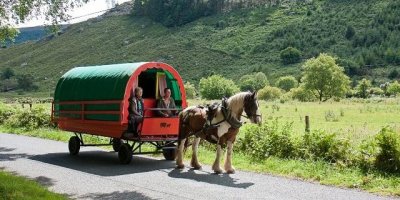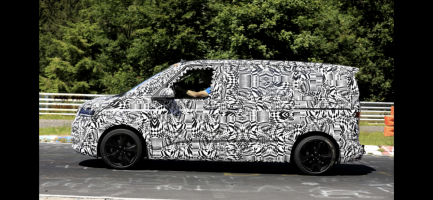H
You are using an out of date browser. It may not display this or other websites correctly.
You should upgrade or use an alternative browser.
You should upgrade or use an alternative browser.
G
GrumpyGranddad
Guest User
Calimili
I can see you guys already planning 20" alloys , lowering it , mud flaps , the lotVW is also working on a totally green van codenamed the GG8, due to be released by 2030.
View attachment 78121
dripster
Lifetime VIP Member
I wonder if you can get the horse remapped...I can see you guys already planning 20" alloys , lowering it , mud flaps , the lot
Algor
Absolutely, the stance is all wrong on thatI can see you guys already planning 20" alloys , lowering it , mud flaps , the lot
Corradobrit
And that's just on the powertrain.I can see you guys already planning 20" alloys , lowering it , mud flaps , the lot
Nand0
Hi CalimiliCertainly. You are from Switzerland, do you speak german? google translation below checked by me.
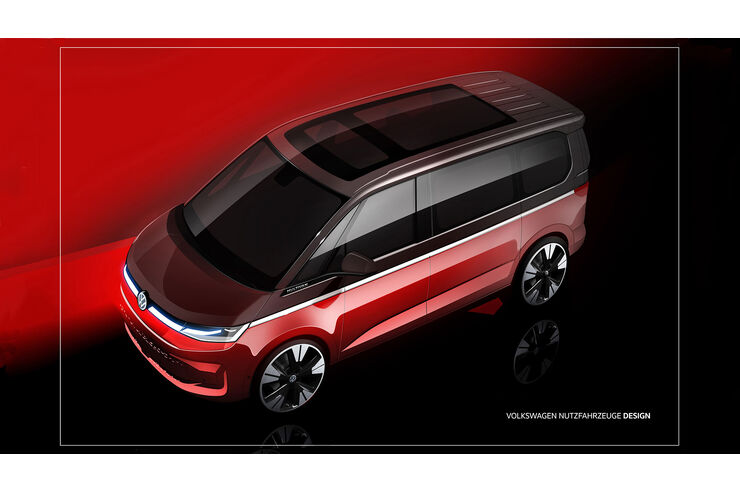
Volkswagen T7 (2021): Längerer Radstand und größere Spurbreite
Vom Volkswagen T7 ist bislang bekannt: Die siebte Version des Transporters soll auf dem MQB gebaut werden. Der Transporter wird 2021 Premiere feiern, promobil hat erste Fotos und Infos.www.promobil.de
Mit der MQB-Plattform hat der T7 also eher eine Pkw-Basis, die zwar bestimmt komfortabel, aber weniger robust sein wird. Beispielsweise wird der MQB nicht so eine hohe Nutzlast zur Verfügung stellen, wie sie gewerblich genutzte Fahrzeuge in der Regel benötigen. Als klassisches Nutzfahrzeug bleibt deshalb der T6.1 weiterhin verfügbar, auch nach dem Marktstart des T7.
Trotz vieler Anpassungen wird sich der neue VW T7 sicherlich schwertun. Als Campingbus ist die Zuladung zu gering, weshalb WohnmobilistInnen wohl eher auf den 6.1 zurückgreifen werden, der durch größere Kapazitäten überzeugt. Ein anderes Problem bleibt die Elektromobilität. Der Wunsch nach einem mit Strom angetriebenen Campingbus mit ordentlich Reichweite bleibt unerfüllt.
and :
https://www.auto-motor-und-sport.de/neuheiten/vw-bus-t7-2021-fotos-daten-design-motoren/
Der Nachteil des MQB: Die Plattform ist nicht für den harten Einsatz als Nutzfahrzeug ausgelegt – daher bleibt der VW T6.1 auch nach der Markteinführung des T7 als Nutzfahrzeug und California im Programm.
Translation for the forum:
With the MQB platform, the T7 has more of a car base, which will certainly be comfortable, but less robust. For example, the MQB will not provide as high a payload as commercially used vehicles usually require. As a classic commercial vehicle, the T6.1 will therefore continue to be available, even after the market launch of the T7.
Despite many adjustments, the new VW T7 will certainly struggle. As a camping bus, the payload is too low, which is why mobile home owners are more likely to fall back on the 6.1, which impresses with its larger capacities. Electromobility remains another problem. The desire for an electricity-powered camper van with a decent range remains unfulfilled.
The disadvantage of the MQB: The platform is not designed for tough use as a commercial vehicle - so the VW T6.1 will remain in the range even after the T7 has been launched as a commercial vehicle and California.
Thanks for the links. Those are "journalists" making those statements, whereas you said "VW confirmed the T7 won't be used as a platform for the California". Hence why I inquired about the source of that information.
I have seen other journos claiming that the California will indeed be made on the T7.
Bottom line, until VW shows their cards, you can make arguments both ways. It's even possible they will have yet another California based on the T7, alongside the T6.1. Personally I don't see the point of the Caddy California, but there it is, so this idea is not as crazy as it may seem at first.
Calimili
I think we agree., it's a question of definitions. To me a "California" is a camper that sleeps 4 people with an elevating roof. I think when 99% people hear VW California they think of that, most likely with a kitchen and fridge, since the T2 era/Westfalia.Hi Calimili
Thanks for the links. Those are "journalists" making those statements, whereas you said "VW confirmed the T7 won't be used as a platform for the California". Hence why I inquired about the source of that information.
I have seen other journos claiming that the California will indeed be made on the T7.
Bottom line, until VW shows their cards, you can make arguments both ways. It's even possible they will have yet another California based on the T7, alongside the T6.1. Personally I don't see the point of the Caddy California, but there it is, so this idea is not as crazy as it may seem at first.
It is unlikely that a T7, due to weight, range, space will allow for that. But they could produce a T7 California similar to a Caddy California. Next they may put a comfort mattress on a Passat boot with a little Camp Bistro from Campingaz and call it "Passat California".
But what I consider THE California, currently is on a T6.1 chassis and most likely to continue on that platform.
Nand0
I haven't seen anything about the load weight capacity of the T7, other than journo speculation. I've looked into MQB for clues, but that all seems to be about sharing a common platform where (at least some) parts are interchangeable. Nothing about weights.I think we agree., it's a question of definitions. To me a "California" is a camper that sleeps 4 people with an elevating roof. I think when 99% people hear VW California they think of that, most likely with a kitchen and fridge, since the T2 era/Westfalia.
It is unlikely that a T7, due to weight, range, space will allow for that. But they could produce a T7 California similar to a Caddy California. Next they may put a comfort mattress on a Passat boot with a little Camp Bistro from Campingaz and call it "Passat California".
But what I consider THE California, currently is on a T6.1 chassis and most likely to continue on that platform.
In terms of size, I've so far gathered from a few articles that the T7 will sit 6cm lower, but be a smidge longer (smidge is a well defined international measure btw), and be wider. It's all speculation of course, but I don't see why this would not fit 4 people. If true, it would mean a wider bed up top. About the 6cm lower, we don't know if they have reduced ground clearance considerably meaning interior height is about the same, or how it was achieved. Can only wait and see.
Personally, I quite like the T6.1, and I'm very curious to see what happens with the T7. As I've mentioned elsewhere, the T6.1 won't fit in my garage, so I'm not-so-secretly hoping that a T7 California will be released and that it'll fit. If so, I'm buying. If not, I'll have to go back to the drawing board, and ponder my options.
reserves
Super Poster
VIP Member
Whilst I find all the speculation interesting, as far as I can tell there has been no official announcement or press release regarding the T7 and the California, albeit the official VW press release video I linked to above tried to do this but failed due to vauge use of language.
So when posting it's useful to say "It's rumoured" rather than "This is what's going to happen"
Until there's a statement from VW, it's all rumours
So when posting it's useful to say "It's rumoured" rather than "This is what's going to happen"
Until there's a statement from VW, it's all rumours
Nand0
It's all a marketing strategy to get us to speculate, and have people talking about the T7. It's working thoughWhilst I find all the speculation interesting, as far as I can tell there has been no official announcement or press release regarding the T7 and the California, albeit the official VW press release video I linked to above tried to do this but failed due to vauge use of language.
So when posting it's useful to say "It's rumoured" rather than "This is what's going to happen"
Until there's a statement from VW, it's all rumours
Nand0
Uninteresting teaser with some table doodah:
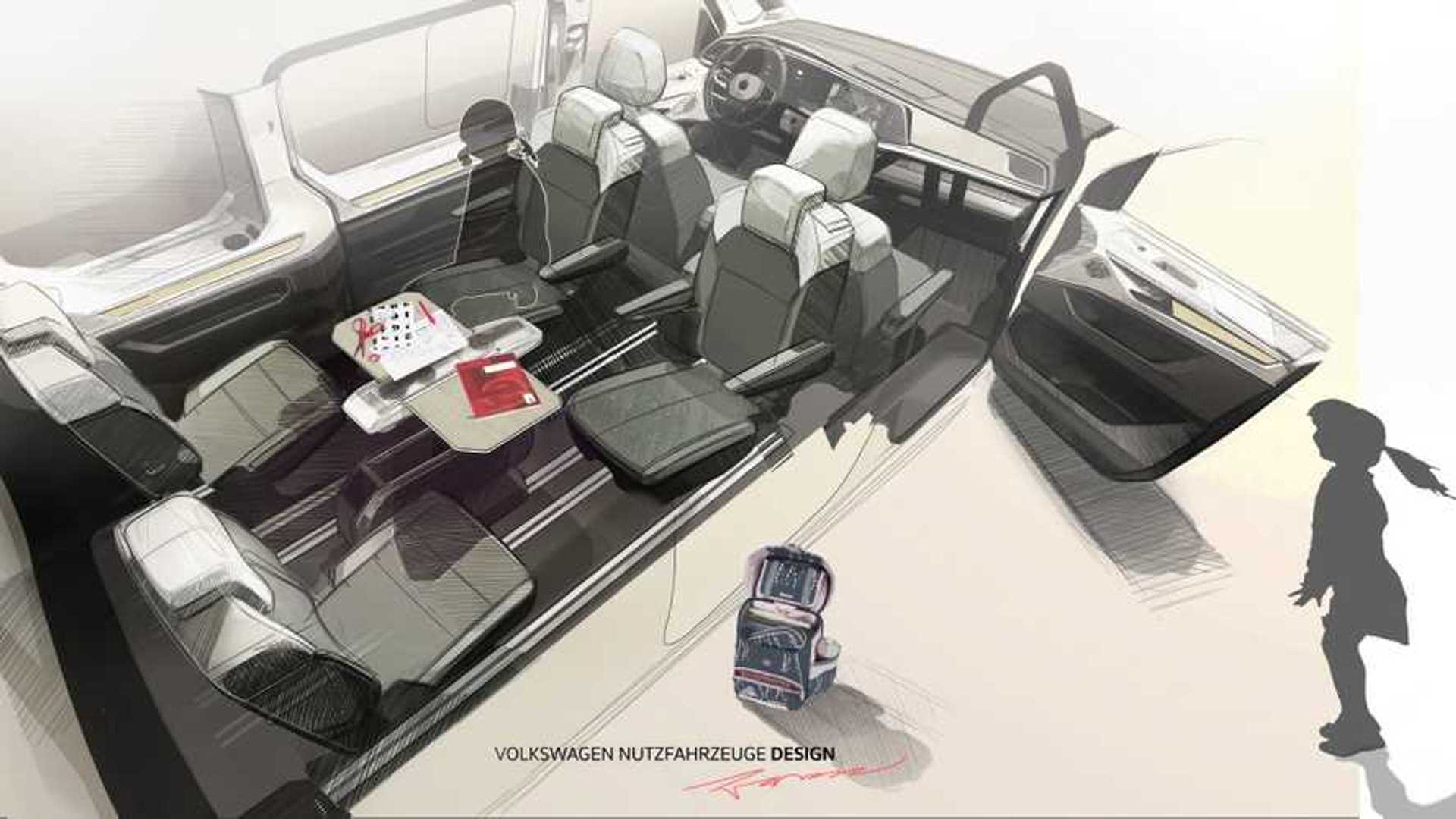
 www.motor1.com
www.motor1.com
All very boring, except for one single sentence: "VW Commercial Vehicles also mentions headroom has remained the same compared to the outgoing T6.1".
We already know that the T7 is 6cm lower than the T6.1, and according to this article, interior headroom is the same. So I'm guessing either they have reduced the ground clearance... or... they will make all 4Motion versions hybrid, meaning they wouldn't need a transmission tunnel, and were able to lower the floor. Or these journalists are spouting "facts" out of their (_|_)

Volkswagen T7 Multivan New Teaser Is All About The Nifty Table
Volkswagen Commercial Vehicles has released a new episode of the teaser campaign for the T7 Multivan, putting the spotlight on the multi-function table.
All very boring, except for one single sentence: "VW Commercial Vehicles also mentions headroom has remained the same compared to the outgoing T6.1".
We already know that the T7 is 6cm lower than the T6.1, and according to this article, interior headroom is the same. So I'm guessing either they have reduced the ground clearance... or... they will make all 4Motion versions hybrid, meaning they wouldn't need a transmission tunnel, and were able to lower the floor. Or these journalists are spouting "facts" out of their (_|_)
blondebier
Boy racer testing?
 www.autoexpress.co.uk
www.autoexpress.co.uk
New 2021 Volkswagen Transporter T7 spied at the Nurburgring | Auto Express
Upcoming Volkswagen Transporter T7 spotted testing around the Green Hell, ahead of its launch later this year
Borris
Super Poster
VIP Member
I wonder if they've fiddled with the emissions of that as well?VW is also working on a totally green van codenamed the GG8, due to be released by 2030.
View attachment 78121
WelshGas
Retired after 42 yrs and enjoying Life.
Super Poster
Lifetime VIP Member
Kampagnendetails
The new Multivan T7
World premiere live here on June 10th.
Past meets future.The world premiere of the Volkswagen T7 Multivan will take place on June 10, 2021 at 6 p.m. as an online event. Advance sales will start at the end of September / beginning of October 2021. The market launch will take place in November. The world premiere of the first Multivan took place in 1985 - 36 years later we are witnessing the world premiere of the fifth generation of the automobile icon.
The demands of the new Multivan
Unchanged, but reinterpreted and designed. Because a Multivan always has to be a real Multivan: functional and flexible, comfortable and spacious, modern and innovative.
inner space
A newly developed rail system enables great flexibility and freedom. The new multifunction table, which also uses the rail system and can therefore be variably positioned throughout the car, is just one of the highlights in the new Volkswagen Multivan.
Exterior design
The new Multivan comes with a characterful look, innovative lighting design and clear, timeless lines. An extended wheelbase with correspondingly distinctive proportions, an elongated bonnet and the dynamic course of the roof combine to create a powerful overall impression. The designers also made great strides in aerodynamics. The goal: lower consumption, higher range.
Plug-in hybrid drive
The T7 will come onto the market for the first time as a plug-in hybrid version. As a Multivan eHybrid, it meets today's expectations. The battery will be housed in the underbody, which saves space and lowers the center of gravity. The new Multivan shows how to reinterpret a basic idea: it remains true to its traditional concept and refines it with numerous innovations. If you implement the Multivan tradition in a modern way and combine it with innovative technologies, multi-traction and digital features, a new, real Multivan is created - one that is ready for a new era.
Corradobrit
Based on the spyshots I've seen these are not positive attributes. Gotta love the marketing spin though.Exterior design
The new Multivan comes with a characterful look, innovative lighting design and clear, timeless lines. An extended wheelbase with correspondingly distinctive proportions, an elongated bonnet and the dynamic course of the roof combine to create a powerful overall impression. The designers also made great strides in aerodynamics. The goal: lower consumption, higher range.
clarinetbcn
T5.1 Beach 140
Top Poster
Lifetime VIP Member
Multi1100
I have really no idea what VW is going to do with the T7, or why they would (will?) take it in production after their announcement of the ID-Buzz. That one will go in production in 2022 (next year)! VW is very much committed to go "electric" as stated in various statements, articles, interviews etc.
The ID-Buzz will have a reach of 400-500 km's. For us as VW camper lovers hopefully the ID-Buzz will also come in a pop-top configuration.
In the mean time the T6.1 in various configurations will satisfy contract builders, group transporters etc. and camper lovers!

 www.vw.com
www.vw.com
The ID-Buzz will have a reach of 400-500 km's. For us as VW camper lovers hopefully the ID-Buzz will also come in a pop-top configuration.
In the mean time the T6.1 in various configurations will satisfy contract builders, group transporters etc. and camper lovers!

VW Electric Cars: Our Selection of EV Cars | Volkswagen
Explore VW's electric cars, from the groundbreaking ID.4 SUV to the iconic ID. Buzz van, for a fun and futuristic driving experience.
blondebier
All the promotional shots I've seen of the the ID Buzz so far show it to be a much smaller vehicle. I can't see that it would be big enough(or support the payload) to replace their current California offering.
The multivan/caravelle are also larger vehicles.
I'd see the the ID Buzz as more of a Touran replacement.
The multivan/caravelle are also larger vehicles.
I'd see the the ID Buzz as more of a Touran replacement.
blondebier
I've just seen that they've got an ID Buzz "Cargo" concept too:
https://www.volkswagen-vans.co.uk/en/electric-vans/id-buzz-cargo.html
(That's probably a good few years away from being production ready)
I am looking forward to seeing more of the T7 when it is released tonight.
https://www.volkswagen-vans.co.uk/en/electric-vans/id-buzz-cargo.html
(That's probably a good few years away from being production ready)
I am looking forward to seeing more of the T7 when it is released tonight.
Multi1100
I first thought the same, but going thru the specs it is 4cm shorter in length, 3 cm less high and width is about the same.All the promotional shots I've seen of the the ID Buzz so far show it to be a much smaller vehicle. I can't see that it would be big enough(or support the payload) to replace their current California offering.
The multivan/caravelle are also larger vehicles.
I'd see the the ID Buzz as more of a Touran replacement.
Swello
A glimpse of the future?
https://arstechnica.com/cars/2021/0...s-driving-extra-ev-range/?comments=1&start=40
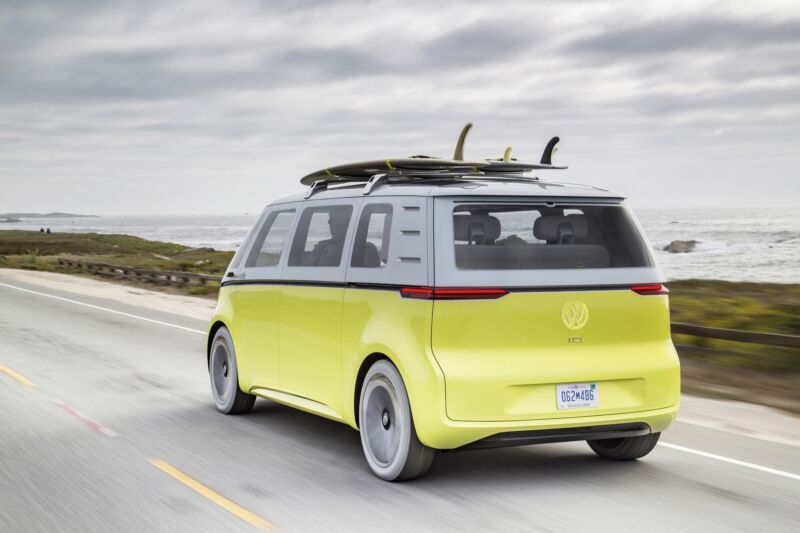
Enlarge / This one is destined to go on sale in 2023. You can watch a short video we made about it back in 2017.
Volkswagen
277WITH 187 POSTERS PARTICIPATING
The future of driving may cost you $8.50 per hour if Volkswagen follows through on its boardroom musings.
The German automaker is considering charging an hourly fee for access to autonomous driving features once those features are ready. The company is also exploring a range of subscription features for its electric vehicles, including “range or performance” increases that can be purchased on an hourly or daily basis, said Thomas Ulbrich, a Volkswagen board member, to the German newspaper Die Welt. Ulbrich said the first subscription features will appear in the second quarter of 2022 in vehicles based on Volkswagen’s MEB platform, which underpins the company's new ID.3 compact car and ID.4 crossover.
The executive said that Volkswagen will also offer video games in cars, similar to Tesla’s arcade. “In the charging breaks, even if they only last 15 minutes, we want to offer customers something,” Ulbrich said. He said the automaker wouldn’t be developing the games themselves, and it’s not clear whether they’ll come preinstalled or be available for purchase through an app store.
Volkswagen’s real moneymaker might be autonomous driving, though. “In autonomous driving, we can imagine that we switch it on by the hour. We assume a price of around seven euros per hour. So if you don’t want to drive yourself for three hours, you can do it for 21 euros,” said Klaus Zellmer, chief sales officer of the Volkswagen brand.
In a swipe at Tesla, he said that by charging hourly fees, VW would make autonomous driving more accessible than “a car with a five-digit surcharge.”
That’s not to say Volkswagen isn’t hoping to make serious money off the subscriptions. In total, Zellmer said he anticipates the subscriptions will eventually make the company hundreds of millions of euros in additional revenue.
Over the past couple of years, Volkswagen has devoted an increasing amount of attention to the software that goes into its vehicles. In 2019, the company launched an effort to streamline its software. At the time, across all VW Group brands, the company had eight different electronic architectures. For an automaker that prides itself on developing a handful of mechanical platforms it can tweak to fit different segments, that diversity of architectures was inefficient and wasteful. VW Group merged all its software departments into one internal group, which changed its name to Cariad in November.
“Cariad is extremely important for our future in the group,” Ulbrich said. “As a brand, the unit develops the basis for future electric cars. This allows us to focus on software for the vehicle and applications for customers.”
Volkswagen isn’t the first car company to mull subscriptions or after-sales purchases. Tesla once offered Model S cars with a 75 kWh battery that was software-restricted to output only 60 or 70 kWh, depending on when the car was purchased. In the case of the 70 kWh models, customers could pay $3,250 to unlock the last 9.33 percent. More recently, Telsa temporarily unlockedextra range in those and other models to give customers affected by hurricanes and wildfires extra juice to drive to safety.
BMW notably charged an $80-per-year subscription for CarPlay in its 2019 models. It was a deal for lessees, who saved $60 over a three-year lease compared with buying the feature outright. But the subscription also meant that BMW could double-dip when reselling the car, offering a similar subscription or outright purchase to the second owner. And if you wanted to keep your car more than three years, the deal was terrible. BMW gave everyone a year of free trials, and before the trials were set to end, the company decided to offer the software free to all owners. (BMW hasn't given up the idea and is testing subscriptions for other features in some markets.)
Whether Volkswagen’s mooted offerings will be embraced by consumers remains to be seen. Temporary range increases could catch on if the price is right. As someone who is now on his third EV, I can tell you that I’d happily pay for temporary range increases if they would save me money over paying for full capacity upfront. Most EVs have batteries that far exceed my daily driving range. Performance increases might be harder to sell on an hourly or daily basis—they might make track days more fun, but I think it would be hard to go back to a detuned model the next day.
Autonomous driving is what will likely make or break Volkswagen’s subscription ambitions. Seven euros—$8.50—per hour is a lot of money to spend to let the car drive itself. Yes, it allows people to do something other than drive, and for some drivers, the extra time will be worth it. But for most, the decision will be harder. In studies of willingness to pay for autonomous driving, the range tends to be $1,000–$7,000, which would buy you between 120–820 hours on Volkswagen’s plan. In 2018, commuters drove an average of 225 hours per year. Drivers typically value their time at 20–40 percent of their wages, and given that the average American wage is around $52,000 per year, or about $26 per hour, Volkswagen isn’t necessarily being unreasonable with its pricing.
https://arstechnica.com/cars/2021/0...s-driving-extra-ev-range/?comments=1&start=40
What would you pay for autonomous driving? Volkswagen hopes $8.50 per hour
Automaker also plans to offer video games that drivers can play while charging.
TIM DE CHANT - Yesterday at undefined
Enlarge / This one is destined to go on sale in 2023. You can watch a short video we made about it back in 2017.
Volkswagen
277WITH 187 POSTERS PARTICIPATING
The future of driving may cost you $8.50 per hour if Volkswagen follows through on its boardroom musings.
The German automaker is considering charging an hourly fee for access to autonomous driving features once those features are ready. The company is also exploring a range of subscription features for its electric vehicles, including “range or performance” increases that can be purchased on an hourly or daily basis, said Thomas Ulbrich, a Volkswagen board member, to the German newspaper Die Welt. Ulbrich said the first subscription features will appear in the second quarter of 2022 in vehicles based on Volkswagen’s MEB platform, which underpins the company's new ID.3 compact car and ID.4 crossover.
FURTHER READING
As important as the Beetle? Two days with Volkswagen’s electric ID.4The executive said that Volkswagen will also offer video games in cars, similar to Tesla’s arcade. “In the charging breaks, even if they only last 15 minutes, we want to offer customers something,” Ulbrich said. He said the automaker wouldn’t be developing the games themselves, and it’s not clear whether they’ll come preinstalled or be available for purchase through an app store.
Volkswagen’s real moneymaker might be autonomous driving, though. “In autonomous driving, we can imagine that we switch it on by the hour. We assume a price of around seven euros per hour. So if you don’t want to drive yourself for three hours, you can do it for 21 euros,” said Klaus Zellmer, chief sales officer of the Volkswagen brand.
In a swipe at Tesla, he said that by charging hourly fees, VW would make autonomous driving more accessible than “a car with a five-digit surcharge.”
That’s not to say Volkswagen isn’t hoping to make serious money off the subscriptions. In total, Zellmer said he anticipates the subscriptions will eventually make the company hundreds of millions of euros in additional revenue.
Over the past couple of years, Volkswagen has devoted an increasing amount of attention to the software that goes into its vehicles. In 2019, the company launched an effort to streamline its software. At the time, across all VW Group brands, the company had eight different electronic architectures. For an automaker that prides itself on developing a handful of mechanical platforms it can tweak to fit different segments, that diversity of architectures was inefficient and wasteful. VW Group merged all its software departments into one internal group, which changed its name to Cariad in November.
“Cariad is extremely important for our future in the group,” Ulbrich said. “As a brand, the unit develops the basis for future electric cars. This allows us to focus on software for the vehicle and applications for customers.”
Willingness to pay
Automakers have been salivating over the idea of subscription revenue for years. As more features in vehicles are managed through software, the thought of flipping a switch to enable or disable them has grown more and more appealing. And after watching software companies make the switch, it’s no surprise that car companies are taking serious steps to bake subscriptions into their offerings.FURTHER READING
Tesla remotely extends car batteries to help with Hurricane MichaelVolkswagen isn’t the first car company to mull subscriptions or after-sales purchases. Tesla once offered Model S cars with a 75 kWh battery that was software-restricted to output only 60 or 70 kWh, depending on when the car was purchased. In the case of the 70 kWh models, customers could pay $3,250 to unlock the last 9.33 percent. More recently, Telsa temporarily unlockedextra range in those and other models to give customers affected by hurricanes and wildfires extra juice to drive to safety.
BMW notably charged an $80-per-year subscription for CarPlay in its 2019 models. It was a deal for lessees, who saved $60 over a three-year lease compared with buying the feature outright. But the subscription also meant that BMW could double-dip when reselling the car, offering a similar subscription or outright purchase to the second owner. And if you wanted to keep your car more than three years, the deal was terrible. BMW gave everyone a year of free trials, and before the trials were set to end, the company decided to offer the software free to all owners. (BMW hasn't given up the idea and is testing subscriptions for other features in some markets.)
Whether Volkswagen’s mooted offerings will be embraced by consumers remains to be seen. Temporary range increases could catch on if the price is right. As someone who is now on his third EV, I can tell you that I’d happily pay for temporary range increases if they would save me money over paying for full capacity upfront. Most EVs have batteries that far exceed my daily driving range. Performance increases might be harder to sell on an hourly or daily basis—they might make track days more fun, but I think it would be hard to go back to a detuned model the next day.
Autonomous driving is what will likely make or break Volkswagen’s subscription ambitions. Seven euros—$8.50—per hour is a lot of money to spend to let the car drive itself. Yes, it allows people to do something other than drive, and for some drivers, the extra time will be worth it. But for most, the decision will be harder. In studies of willingness to pay for autonomous driving, the range tends to be $1,000–$7,000, which would buy you between 120–820 hours on Volkswagen’s plan. In 2018, commuters drove an average of 225 hours per year. Drivers typically value their time at 20–40 percent of their wages, and given that the average American wage is around $52,000 per year, or about $26 per hour, Volkswagen isn’t necessarily being unreasonable with its pricing.
WelshGas
Retired after 42 yrs and enjoying Life.
Super Poster
Lifetime VIP Member
I notice the DSG selector has Drive and I presume “ S” stands for Sport mode.Meh.
Similar threads
- Replies
- 28
- Views
- 2K
P
About us
The VW California Club is the worlds largest resource for all owners and enthusiasts of VW California campervans.



